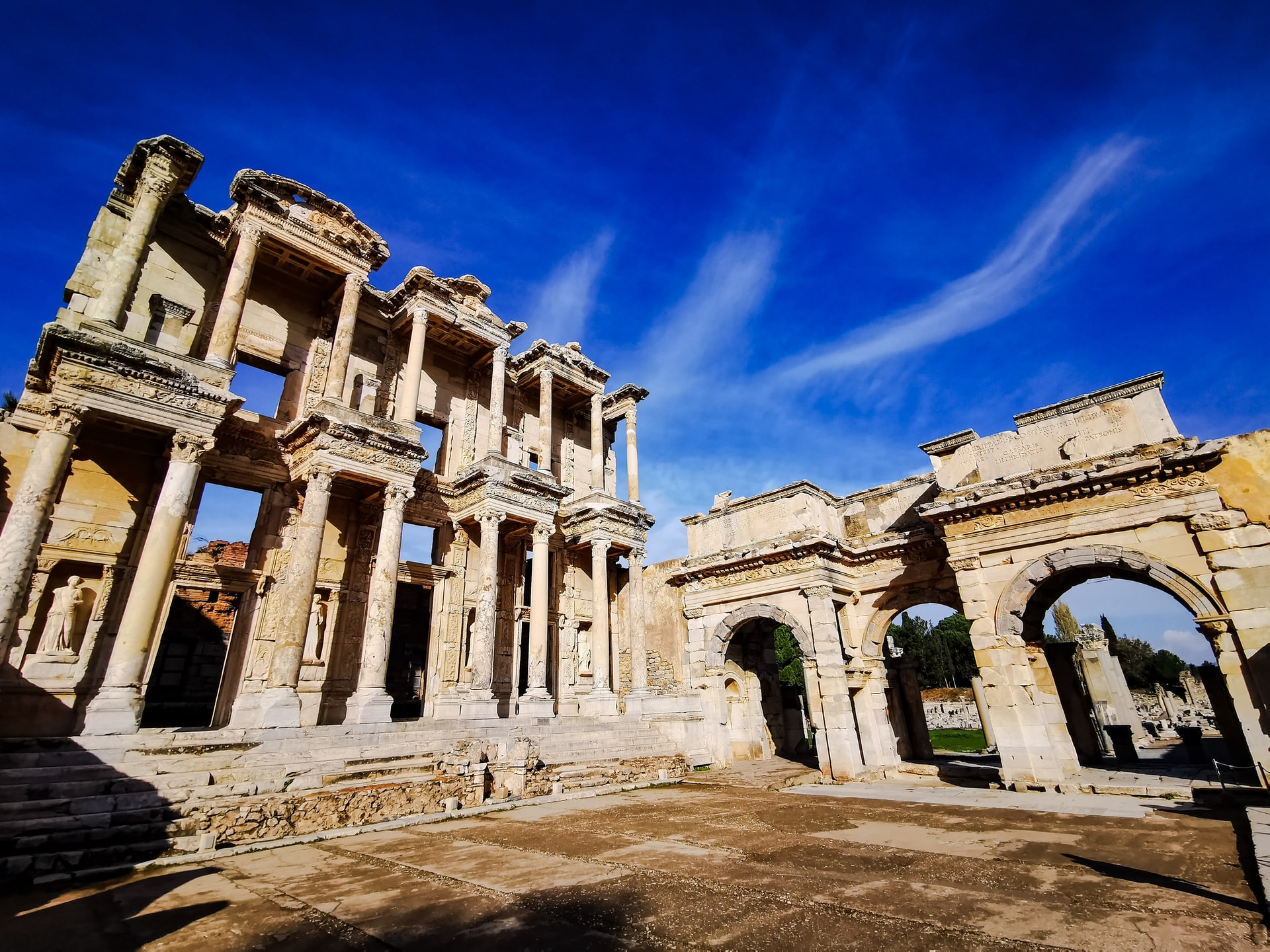Since ancient times, Ephesus was a prime location with a big river, plenty of fertile lands, and a sea full of fish. Ephesus is an old city, even among ancient settlements. Ephesus was founded around 8600 BC.
Ephesus grew over the centuries and became one of the most important cities in the world. In the 1st century, it was the second-most populous city in the world after Rome. Ephesus was also the capital of the Asian province of the Roman Empire, and it was competing with Rome in many aspects.
I love Ephesus and have been to this ancient city many times since my childhood. I want to tell you a lot, but I will try to keep my post as simple as possible and not bore you with details.
I have other articles about specific places around this city, and I will be linking to them as I go. If you want to learn more, you can click on my other articles.
Map of Ephesus
Places that I will provide information are pinned down on the map below.
Another map here
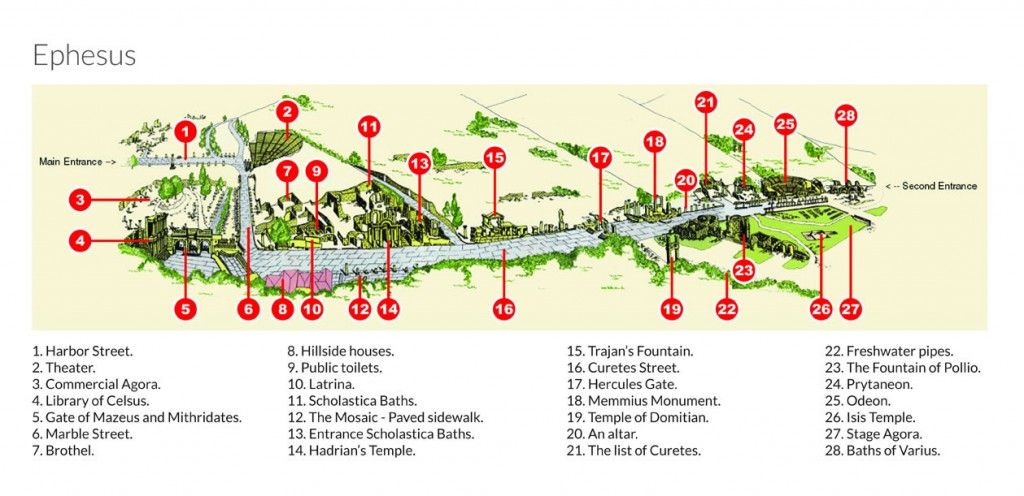
If you wish to learn more about the nearby area, you can read my Kusadasi, Sirince, Selcuk guides.
Is Ephesus worth a visit?
It is definitely worth visiting Ephesus. Ephesus is one of the top stops to visit in Turkey. In Ephesus, you will see something similar to Rome. Currently, only %15 of the Ephesus surveyed by archeologists, yet it is the most extensive archeological excavation in the world. You can easily spend 4 hours just walking around the ancient city.
Ephesus is famous for many marvels from the times that Ephesus played many crucial roles in our world history. Besides being a Unesco World Heritage Site, Ephesus is home to one of the 7 Wonders of the World. Ephesus had a vital role in the first days of Christianity.
Ephesus welcomed St.John, the youngest of the twelve apostles of Jesus, and protected Mother Thesera until her final days. Ephesus is mentioned many times in the New Testament. Many early pilgrimage routes end in this city, more specifically, the House of the Virgin Mary in the hills of Ephesus.
The excavations started at the beginning of this century and continue to unearth many marvels of this city. Ephesus is a well-preserved ancient city and an excellent destination to experience a chapter in human history.
Let’s start.
When was Ephesus founded?
Ephesus was founded in the late stone age (Neolithic period) around 8500 BC. The first settlers were indigenous people of Asia Minor. Yet, Romans believed that the Amazons founded this city in honor of their beloved Queen Diana.
The Temple of Artemis (also called the Temple of Diana or Artemission) is as old as Ephesus itself. It is believed to be the first marble temple with columns in history. There were three Temple of Artemis in the same place. The second temple of Artemis, which is considered a world wonder, was built around 500 BC.
Facts about Ephesus, Goddesses, Wonder Women, Virgin Mary
Ephesians were fond of mother nature and femininity. They were welcoming, gentle and mercantile people. However, they were not weak. On the contrary, they were strong and very protective. You can see this feature in all their marvels, architecture, and Goddesses.
Ephesus Artemis is a mix of the old Anatolian God of Kybele and Greek Artemis. Artemis is a strong and beautiful woman yet gentle and motherly.
Artemis is Diana in the eyes of Romans. Romans believed Amazons founded Ephesus and Ephesians are descendants of Amazons.
Ephesians Artemis still lives among us today. In popular fiction, it is Wonder Woman, Queen Diana of Amazons.
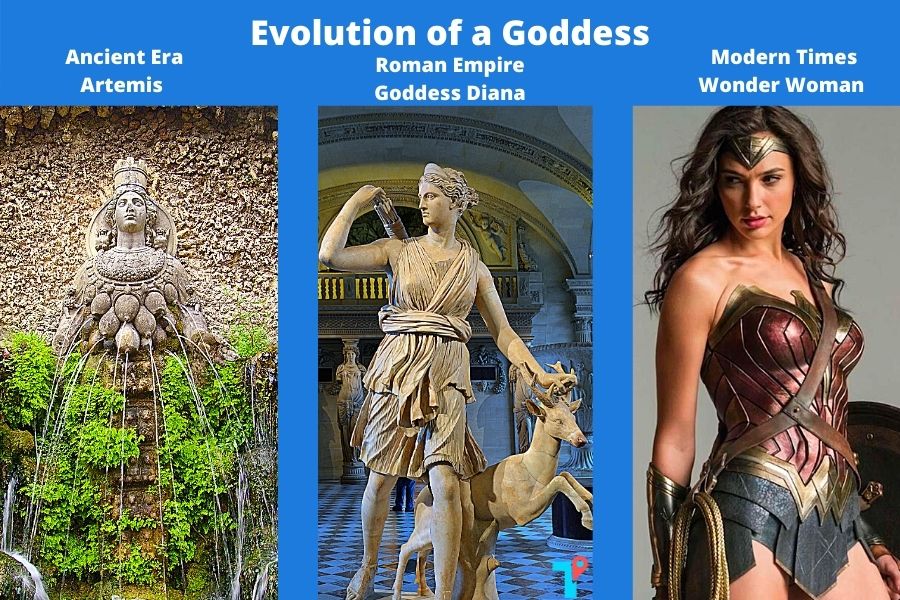
Ephesus was a peaceful place with a high tolerance for many religions and races. The youngest of 12 Apostles of Jesus, Saint John, was welcomed here when Christians were persecuted elsewhere in the Roman Empire. From that point on, Ephesus played a crucial role in spreading the faith and protecting Christians. For these reasons, Ephesus has been mentioned many times in the New Testament.
Virgin Mary was entrusted to Saint John by Jesus himself. Saint John felt so secure in Ephesus that he left Mother Mary for the care of Ephesians. From that point on, Ephesians adored Virgin Mary and loved her like they once loved their Goddess Artemis.
Mother Mary spent the rest of her life on Ephesus. Her house on the hills of the Ephesus is a pilgrimage point visited by centuries.
When did Ephesus fall? When was Ephesus abandoned?
After the spread of Christianity during the 1st and 2nd centuries, Ephesus became the second more populous city on the earth. Ephesus, under Roman Rule, was a thriving metropolis.
As Ephesus provided sanctuary to Christian, its population rose rapidly. At the end 2nd century, Ephesus’s population was estimated to be around 250.000-400.000 people. Ephesus was also the capital of the Asian Province of the Roman Empire. At that time, only Rome could rival Ephesus.
Ephesus is not a city anymore, and you may wonder how a thriving metropolis like Ephesus turned into a ghost town. There are many reasons why Ephesus was abandoned.
The primary reason for the abandonment of Ephesus was the Cayster River Sands brought by the river filled the sea and cut the city’s access to the sea. For this reason, Ephesus’s commercial life died slowly. Ephesus was a coastal city, and now the sea is 5 km away.
The other reason is Constantinople (Istanbul) became the capital of the East Roman Empire, further diminishing the city’s administrative role in the region.
The short live Arab invasions and earthquakes in the 6th and 7th centuries accelerated the decline of Ephesus, and around this time, it was only a significant pilgrimage stop. Yet, acceptance of Islam in Asia minor also decreased the city’s importance, and Ephesus was buried by sands of time for a long time.
Things to Know Before Coming to Ephesus
When to visit Ephesus?
You can visit Ephesus all year around. If you are asking for the best months to visit Ephesus is April and May. The weather will be warm and not too hot. Nature will be beautiful with full green tones, and flowers will be everywhere. Yet, Ephesus will not be crowded as it is in the summer months.
Most visitors come to Ephesus in the summer, and it can be challenging to visit Ephesus in the heat of summer.
If you are coming in the summer, the best time to visit Ephesus is to be there when the doors are first open. The doors open at 9 am, if you come around this time, you can enjoy the city without crowds. Tourist busses start to arrive around 10 am. In summer, if you come early, you can take fantastic pictures without crowds.
While Ephesus is perfectly safe to wander around in the summer months, the weather can be hot. With the sun on top, you may not enjoy Ephesus as I do. Make sure you have water, sunscreen, and a hat in your bag.
If you are coming in spring, you should align your calendar to see the spectacular Camel Wrestling Festival, which takes place in the Hippodrome of Ephesus.
Ephesus Visiting Hours
Ephesus is open all days of the year, including bank holidays. Only on the first day of religious holidays it is closed for half day in the morning.
Between April 1st to October 1st, Ephesus ancient city opens at 9:00 am and closes at 5:30 pm.
Between October 1st to April 1st, Ephesus ancient city opens at 8:30 am and closes at 5:30 pm.
How much time do you need in Ephesus?
Ephesus covers a vast area with many things to see. Remember that you are visiting one of the biggest metropolises in the world. You should plan to spend at least 2-4 hours in Ephesus. The guided tourist tours also take 2 hours to cover the area.
But if you wish to see things like Saint Paul Church, Temple of Artemis, Ephesus Museum, Virgin Mary house, you can easily spend your day around Ephesus.
Is there an entrance fee for Ephesus?
There is an entrance fee for Ephesus. It is around 10-15 USD, depending on the Turkish currency value. For the House of Virgin Mary, a separate entrance fee of 8 USD per person needs to be paid. The Temple of Artemis is free to visit.
Virtual Tour of Ephesus and Ephesus Museum
You may try the virtual tour of Ephesus, but I should warn you, it is not the same thing.
Here are the links to Ephesus Ancient City and Ephesus Museum virtual tours prepared Turkish Cultural Ministry.
At the time that I wrote this post, the Ephesus Museum virtual tour was not translated, and it was only available in Turkish.
Everyone can enjoy ancient city virtual tours. Additionally, here is an alternative virtual tour of Ephesus by Google. If you click here, you will start the virtual tour at the entrance of Ephesus.
19 Things to see in Ephesus
There are many treasures to overlook in Ephesus without knowing their value. I compiled the most important places so that you will not miss them.
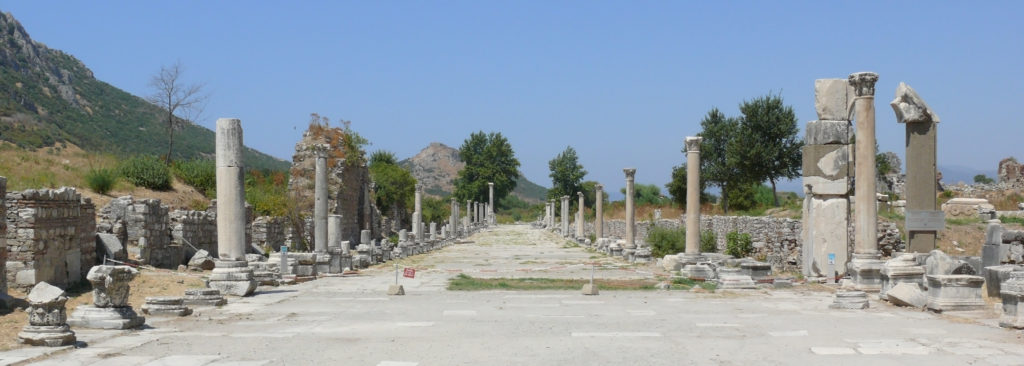
Harbor Street
This street is the longest in the ancient city of Ephesus. It connects the theater with Ancient Harbor. This road always makes me remember that once Ephesus was a coastal city. I always wonder how beautiful Ephesus should be at those times.
This road is decorated with magnificent columns. In the old times, these columns were also attached with lambs to light the street. This is the road where foreign kings were welcomed into the city, and religious ceremonies were held.
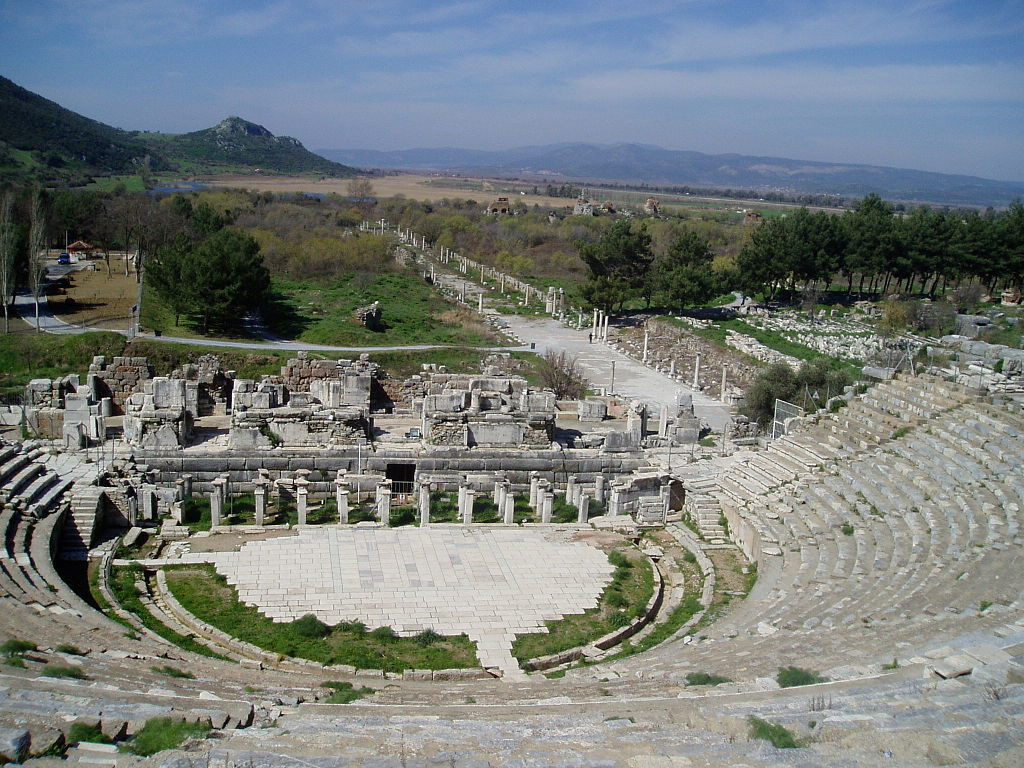
Ephesus Theater
This theater is the largest open-air theater of the ancient period. The theatre has a capacity of 26,000 people. The crying and laughing men symbols used to describe theatre today originated from Ephesus. In the old times, Ephesian actors used these masks to ensure their anonymity.
The performing platform of the theatre is not there. In its original form, it was three-story high. Yet, the theatre is mostly in good condition. In my childhood, there used to be concerts in the theatre. Many times I came here to enjoy those performances, but it is not allowed anymore to preserve the theatre.
This theater is also the place where St. Paul’s sermons took place.
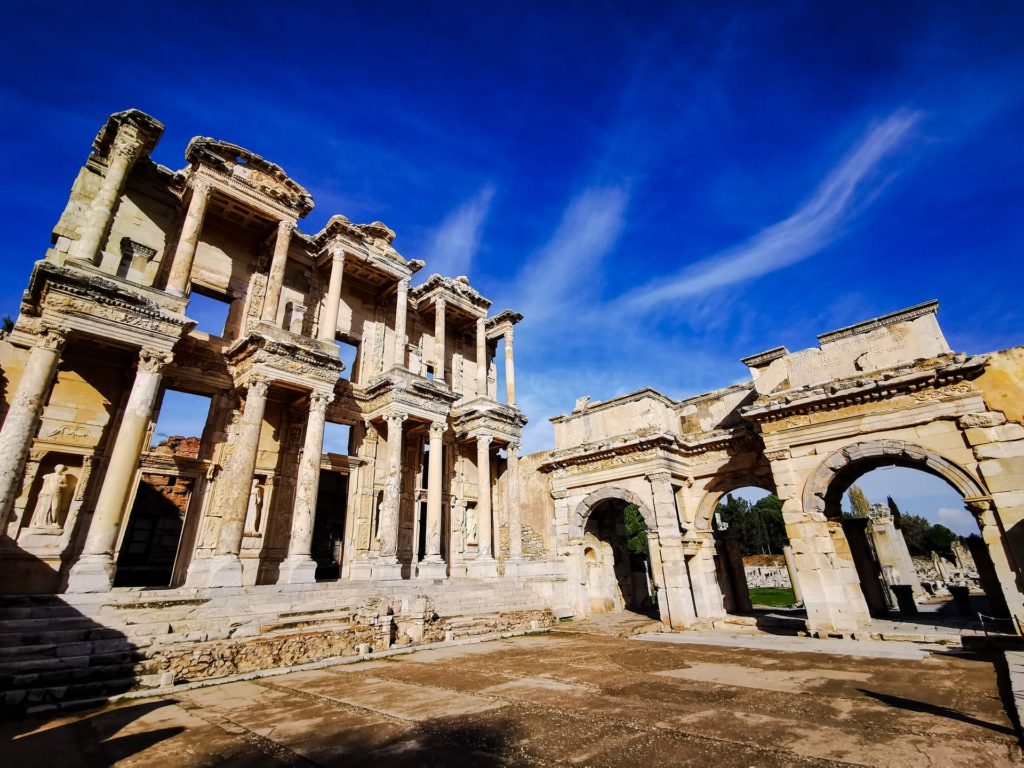
Celsus Library
This library was the third most extensive library of its time. The Great Library of Alexandria was the first, and Pergamon was the second.
It is one of the most beautiful buildings in Ephesus. His son built Celsus Library on behalf of Ephesus governor Celsius, who died in 106 AD. Although the library has a two-story appearance from the outside, it is a single-story building with a high ceiling.
On its front, the building has four sculptures. These sculptures symbolize wisdom (Sophia), intelligence (Ennoia), knowledge (Episteme), and Virtue (Arete).
Fun Fact There is a funny claim about Celcus Library. Pleasure House is located right across from the library, and the claim is that there used to be a secret passage to the pleasure house within the library. It is rumored cheating husbands were pretending to go to the Library and were using this secret passage to Pleasure House.
Gate of Mazeus and Mithridates
This gate is also known as the South Gate of the Agora. It is the gateway from the Celsus Library to Agora. It was financed by two slaves named Mazaeus and Mithridates, who Emperor Agustus freed.
Agora
Located right next to the Celsus Library, Agora was the city’s most important trade and cultural center. Agora was a marketplace with three gates.
The Temple of Serapis
The temple is dedicated to the Egyptian God of Serapis, which is thought to be built between 138-192 AD.
The Temple of Serapis is one of the most interesting structures in Ephesus. The temple is made with granite brought from Egypt. The temple was converted into a Church in later periods.
The Marble Street
This street extends from the modern-day entrance to the library and the theater.
This street is designed for the passage of horse carriages. There are pavements for pedestrians on both sides of the road. The street is also decorated with columns.
The Pleasure House
This house is located at the intersection of Curetes and Marble Street. It is believed that the pleasure house is connected to several other buildings by secret passages.
There is a footprint at the entrance of the house. This footprint is accepted as the first street advertisement in history.
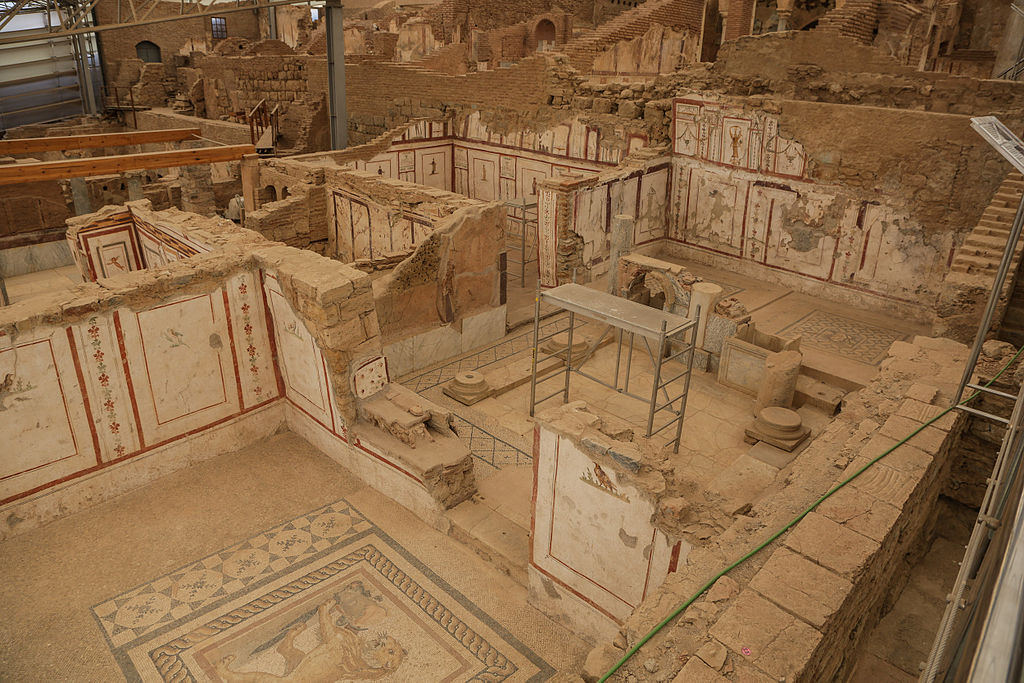
Terrace Houses
You should definitely visit Terrace Houses. I know that you need to pay extra for Terrace Houses, but it is worth every penny. If you are in Ephesus in the mid-day with all that crowd and hotness in summer, it is relaxing to visit this part in shade and with fewer crowds.
Terrace Houses were the luxurious part of Ephesus where wealthy Ephesians lived. The unearthed area in this district is about 4 acres.
The houses were luxurious for the period, and an underfloor heating system was used to heat them. The villas are in good condition and shed light on the daily life of wealthy Ephesians.
Public Toilets (Latrina)
Public toilets in Ephesus are not only used for everyday needs but also for socializing. These toilets are located just behind Scholastica Baths.
The public toilets were also cooled and heated by water. Because there was no toilet paper at the time, vinegar and sponges were used for cleaning.
Scholastica Baths
Scholastica Baths is a large bathhouse structure thought to have been built in the second half of the 1st century AD or the beginning of the 2nd century, which will remain on your right as you go down the main street to Curetes Street. It is known that the baths were restored by a Christian woman named Scholastica in AD 400. Therefore, its name is Scholastica Baths.
These baths could house a thousand visitors and library and entertainment rooms along with bathing areas.
This ancient bathing tradition is still part of our culture. Turkish hammams rely on thousands of years old culture.
Mosaic Pavement
In front of the Hadrian Temple, there is this 5-meter wide mosaic pavement.
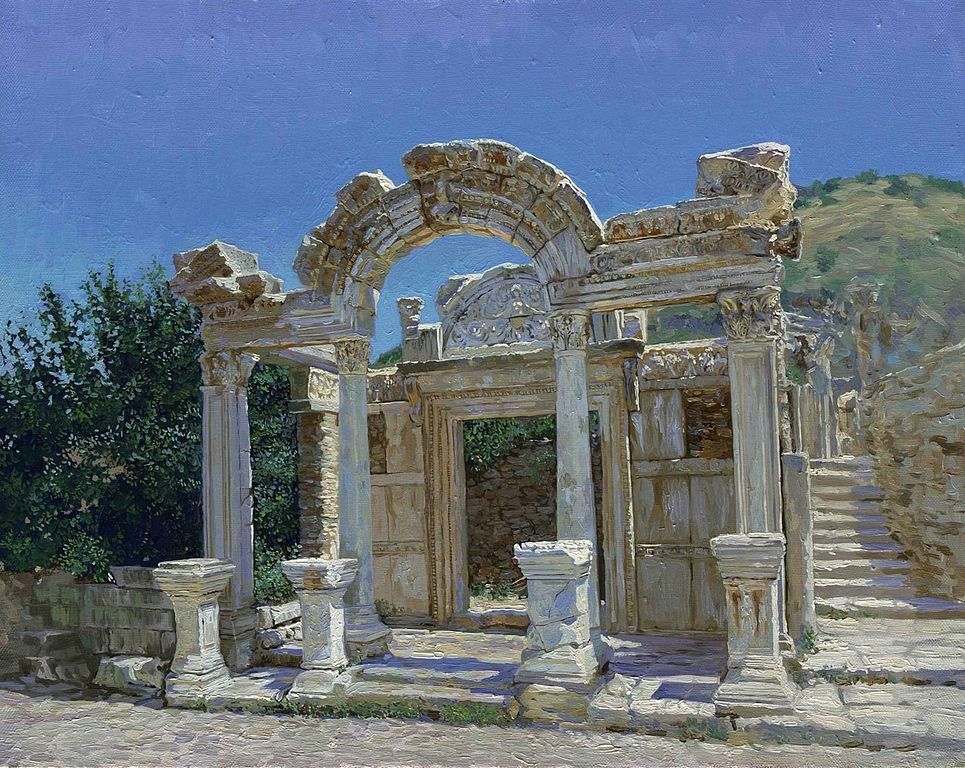
The Hadrian Temple
Hadrian’s Temple is a temple built in the name of the Roman Emperor Hadrian. The temple’s construction aims to honor Emperor Hadrian, who visited Ephesus in AD 128.
Trajan Fountain
Trajan’s Fountain was built between 102-114 AD in the name of Roman Emperor Trajan and Artemis of Ephesus. The fountain originally had two floors.
Some of the sculptures of the fountain are exhibited today in the Ephesus Museum and the British Museum.
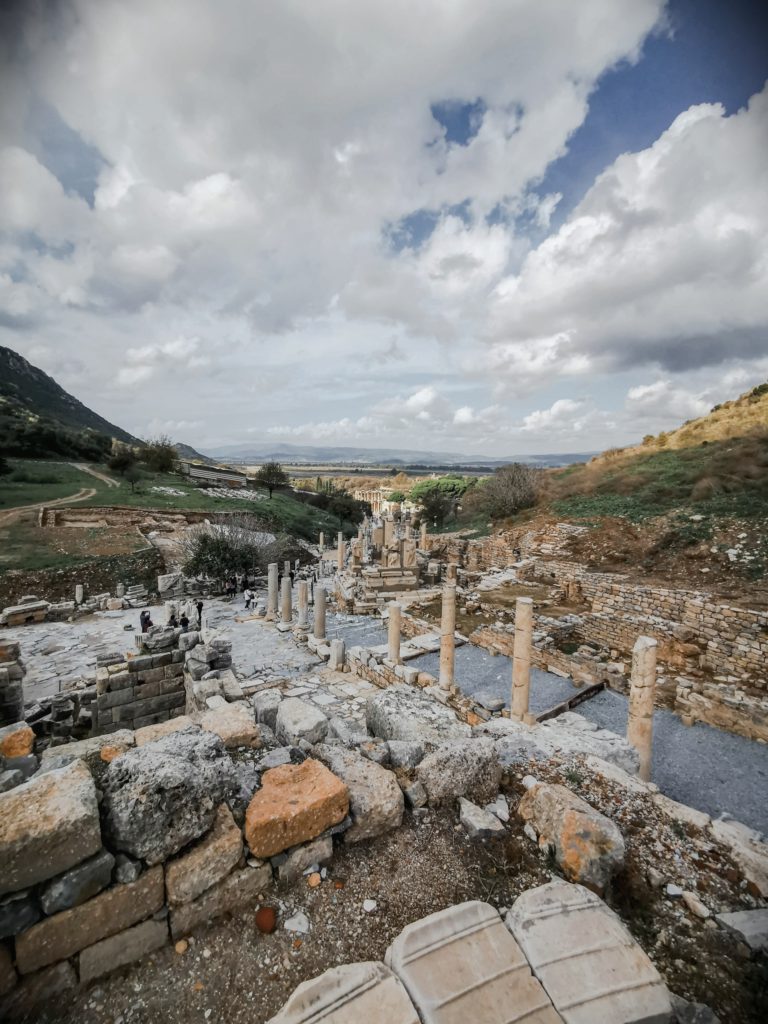
Curetes Street
The main street that starts from the Heracles Gate and goes down to the Celsus Library is Curetes Street. Trajan Fountain, The Hadrian Temple, and Skolastica Baths are located on this street.
Curetes are demigods in mythology. The names of the Curetes ( demigods) are written on the columns on this street. For this reason, it was called “Curetes Street.”
The Hercules (Heracles) Gate
Heracles Gate was built in the 4th century BC. The name of the gate comes from “Heracles” (Greek Mythology) and “Hercules” (Roman Mythology).
It is known that only the nobility of Ephesus could pass through the door.
Memmius Monument
Memmius Monument is an honorary monument built in the name of Gaius Memmius. The memorial has a shape of a tower, and the virtues of Gaius Memmius are depicted on the pillars of the monument.
The Domitian Temple
Domitian Temple is a temple built in the name of Emperor Domitianus between 81-96 AD. Emperor Domitian was cursed for maintaining a cruel rule after his death. With the decision of the Roman Senate, it was decided to delete his name from all inscriptions.
However, the Ephesians did not want to destroy the temple, and they found a practical solution. Ephesians cut Emperor Domitianus’s head from the emperor’s statue in the temple. Ephesians replaced the head of the Domitianus with the head of the previous ruler (father).
Prytaneion – Town Hall of Ephesus
The Prytaneion, or Town Hall, was built in the 1st century during the reign of Emperor Augustus. This place was the center of city administration and diplomatic relations.
Odeon
One of the structures unique to Roman Ancient cities is the odeons. Odeons are small amphitheaters constructed to allow small group meetings. Odeon’s primary purpose was to hold city council meetings and discuss issues related to the city.
The Odeon in Ephesus was built around 100 AD.
Things to See Around Ephesus
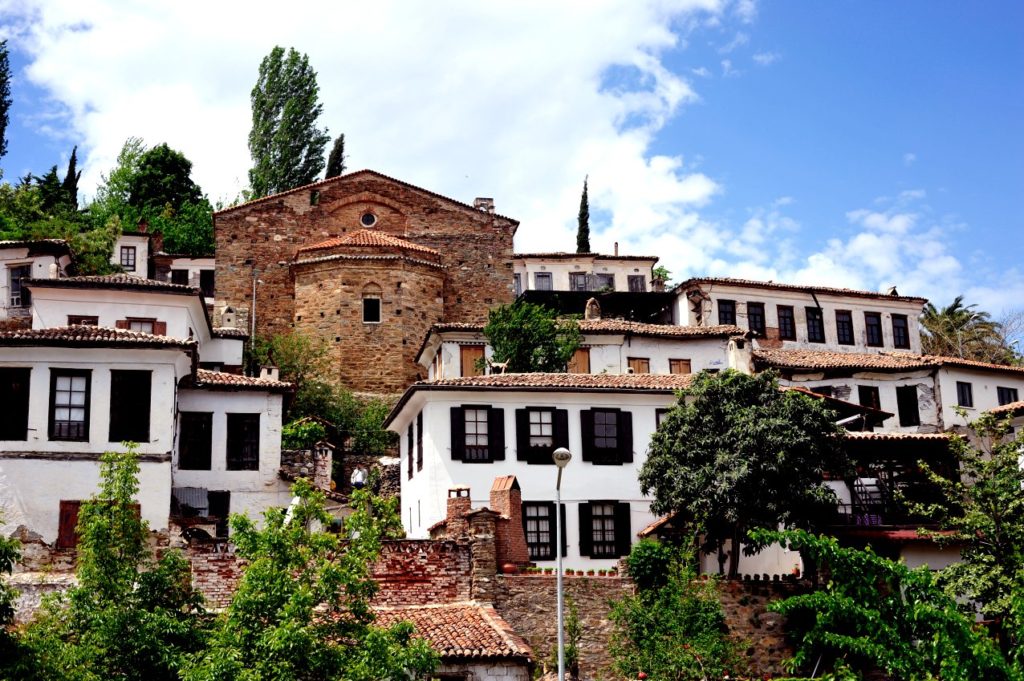
Sirince
With less than a thousand permanent residents, this little village hosts more than a million tourists every year.
This lovely village is also called Ephesus on the Hills. Sirince is famous for many things; wine, traditional houses, historical sites, festivals, and beautiful people are just a few to list. You can visit this town all year.
Sirince is a 10-minute driving distance to Ephesus ancient city. Check my guide on Sirince if you wish to learn more about Sirince.
Temple of Artemis (Artemission)
It is said that the Temple of Artemis was the most beautiful of all the Seven Wonders of the World.
“But when I saw Artemis’s house built on clouds, all the other wonders lost their shine, and I said “Hear! Outside of Olympus, the Sun has never looked at anything this beautiful “ (Antipater, Greek Anthology [IX.58])
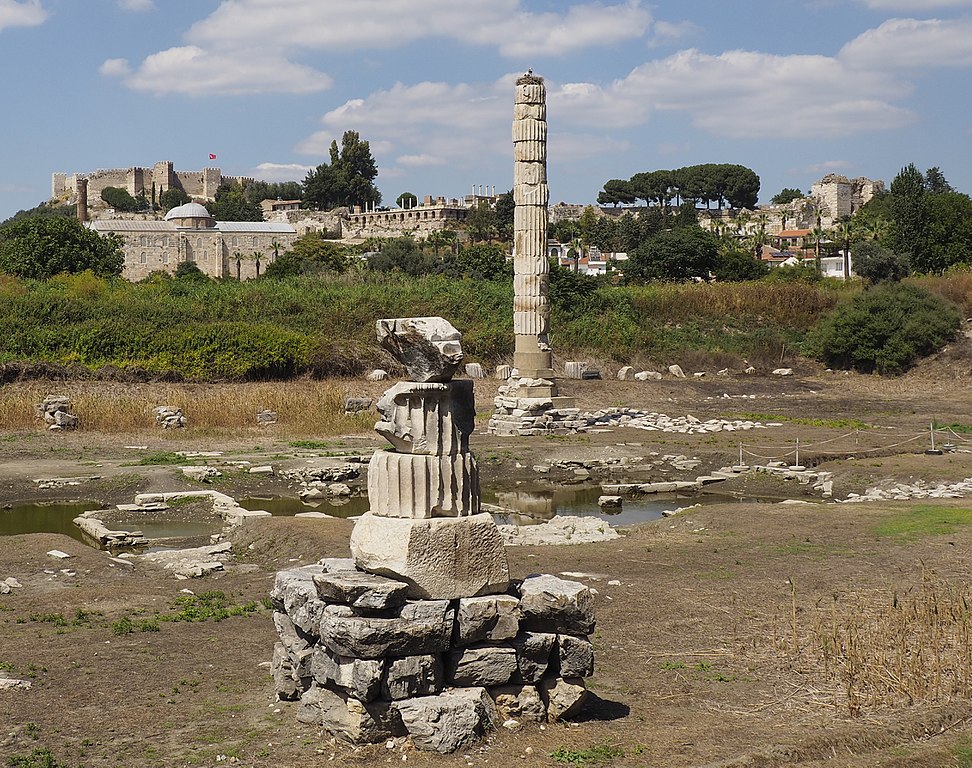
The Temple of Artemis was destroyed three times. Each time the Temple of Artemis was rebuilt, it became more beautiful. Unfortunately, today the Temple of Artemis is lost sand of the time.
It is believed that most of the remnants of the Temple of Artemis are used in the construction of Hagia Sophia in Istanbul.
Check my guide if you wish to learn more about Temple Artemis.
House of Virgin Mary
The East Roman Church, or more accurately, Orthodox Church, believes Virgin Mary spent her last years with St. John in Ephesus.
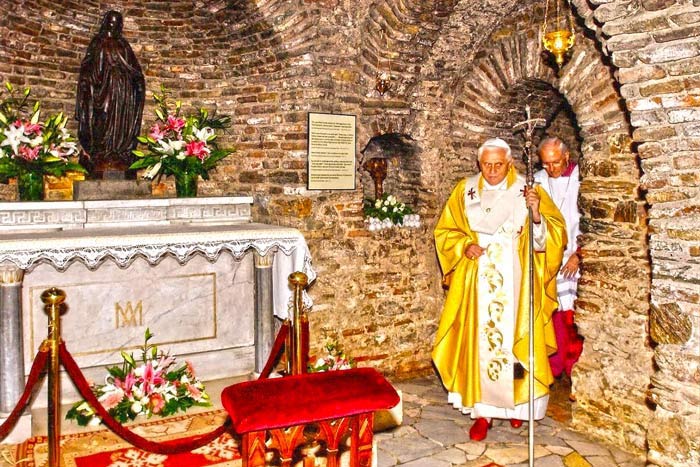
The Catholic Church never accepted this statement officially, yet many Popes (including Paul VI, John Paul II, and Benedict XVI) visited the House of the Virgin Mary.
The spring under the house is believed to be holy water.
The Seven Sleepers Cave
The cave is near the Ephesus ancient city entrance.
Christianity and Islam share the same story of Seven Sleepers, with only minor differences.
The legend says seven people took sanctuary in a cave while escaping the tyranny of their ruler. The imperial forces found them and trapped them inside the cave by closing the cave entrance.
200-300 years after this event, someone opens the entrance to the cave and sees seven sleepers inside. The reality came to light when some of the seven sleepers went to the village to buy food. The villagers understood that they were ancient people because they were using old coins to buy food.
There are four places in Turkey and 33 different spots in the world, claiming to be the cave where the Seven Sleepers slept.
How can you travel to Ephesus?
Sirince is exactly 80 km away from Izmir’s city center. From Izmir Central Bus Station (Otogar) you can take buses to Selcuk.
Also, you buy bus tickets from any major city to Selcuk. Nearly all the busses traveling to Kusadası or Bodrum pass through Selcuk. For this reason, it is not hard to find a bus ticket to Selcuk.
If you want a more scenic route from Izmir, you can come to Selcuk by train from Izmir Basmane Train Station. You can check railway tickets from here.
If you are coming to Ephesus from Izmir Adnan Menderes Airport (ADB), you can use airport service buses (Havas). Havas buses to Kusadası, also stop at Selcuk. You can check the timetable from here.
From Selcuk, Ephesus is walkable with a distance of 2 km.
With a car coming to Ephesus is easier. And if you do not have a car, you may not enjoy it as much as I do. Renting a car is an important option to consider.
If you are driving to Sirince;
- Ankara to Ephesus is 620 km, and the travel time will be around 7 hours.
- İstanbul to Ephesus is 541 km, and the travel time will be around 5,5 hours.
- Mugla to Ephesus is 160 km, and the travel time will be around 1,5 hours.
- Balıkesir to Ephesus is 265 km, and the travel time will be around 2,5 hours.
- Manisa to Ephesus is 107 km, and the travel time will be around 1 hour.

